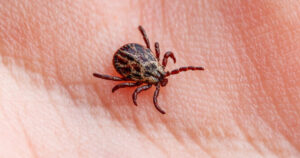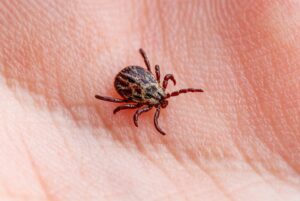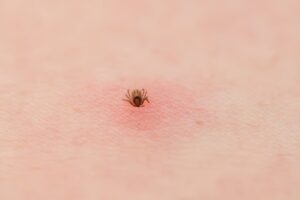
A tick. Credit / Shutterstock
If you live outside the city, close to forests and fields and nature in general, chances are (depending on what country you call home) you’ll be well acquainted with ticks.
Yes, those pesky little arachnids love nothing more than feeding on the blood of mammals, birds, and just about all else they can get their tiny suckers into. And while that doesn’t sound all that dangerous on the face of it (after all, no human is ever going to die of blood loss from a tick bite) ticks do present a set of very real issues.
It’s more than likely that you’ll have heard how ticks can carry diseases that are then transmitted to humans through their bites. These include – but are not limited to – Lyme disease, Rocky Mountain spotted fever, and babesiosis.
You might not be familiar with these illness, but trust me when I say you’re better off living without them. They can have serious, life-altering consequences if they go untreated, and the best way to tackle them is, of course, by taking precautions to never contract them in the first place.
A fairly obvious way of limiting your chances is by doing all the right things where ticks are concerned. You can’t guard one-hundred percent against them, but you can take steps to make sure you limit the possibility of being bitten, which in turn limits the possibility of you contracting one of the aforementioned diseases.
So, what to do if you find a tick has latched on to you?

The first step is to remove it carefully and quickly. Do not just try and pull it off with finger and thumb, as this may cause the tick’s body to detach from its head, leaving the latter part in your skin. Rather, use fine-tipped forceps or tweezers, grasp the tick as close to your skin as possible, and gently pull it free in a single continuous motion.
Take care not to squeeze or twist the tick, as it may then regurgitate its contents into the wound.
Here we come to the next part: disposing of the tick properly. It might seem as obvious as simply throwing it in the trash, but there are actually steps you should be taking to ensure that the particular tick you’ve found will never feed on blood – human or otherwise – again.
For best results, place the tick in a sealed bag or container to prevent future contact with humans and animals. Alternatively, you can wrap it in tissue paper and flush it down the toilet.

Bear in mind that some veterinarians may recommend bringing the tick to the office for identification and further assessment if you’ve found it on your pet. So it might be an idea to keep it in a sealed bag or container after all.
Ticks and pets
In all likelihood, you’ll already perform regular checks for ticks if you own pets, but it can’t hurt to remind you just how important it is. Ticks are often more active in warmer months, though they can survive freezing temperatures, so ensure you’re performing said checks regularly throughout the year.
Search your pet in areas such as the ears, armpits, skin folds, toes, and groin by thoroughly combing through the fur and feeling for any small, firm bumps on the skin.
Remember, keeping your pet tick-free helps keep you and your home tick-free in turn. So it’s certainly worth doing!
If you’ve been bitten
There are a number of things to watch out for if you suspect you’ve been bitten by a tick. Early signs of Lyme disease can include flu-like symptoms, joint pain, and muscle aches.
Other cases may present a red, bullseye-type rash around the site of the bite, indicating possible infection. Certain other tick-borne diseases may present with fever, chills, and fatigue, so be particular mindful if you experience any of these symptoms after having been bitten by a tick.
Needless to say, you should always seek medical help if you believe you’re suffering from symptoms relating to a tick bite. Early detection and treatment of tick-borne diseases can help present the development of more serious complications later on.





